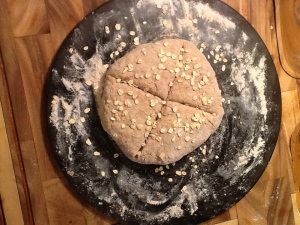Before we know it, March 17th will be upon us and there will be talk of St Patrick’s Day . Unfortunately , it goes with the territory that I will be subjected to all the jokes that I have heard for the seventeen years that I have lived here in the United States. Green beer and cabbage will seep out of the walls and anyone looking for an excuse to drink or get drunk will claim some Irish ancestry. Now, don’t get me wrong, I’m not here to spoil your fun. By all means have a great time . Growing up in Ireland, I did in actual fact eat 365 days of the year and not just on March 17th ! I did not grow up with green beer and soda bread with raisins and caraway seeds was more of a tea loaf or cake. Our soda bread was something else quite different, served as savory rather than sweet.
Much like everything else, this bread evolved over time. If you have a recipe in your family and you love it, then that is all that matters. These tea loaves or cakes require sugar and fruits.
Consider the origins of soda bread. We were a poor nation. A farming nation with a plentiful supply of wheat and dairy. This was an easy to make all-in-one mixture , made with buttermilk. Buttermilk being a by product when making butter. Wholemeal flour was more widely available. Baking Soda was added as a leavining agent.
The average Irish home in the 1800’s did not have an oven so thay baked the bread in a pot known as a ‘Bastible’. This pot was hung/suspended over an open fire and baked.

My sister Gillian & I visiting the historic Muckross Farms in Killarney. Bastible over burning peat fire was used to make bread.
Raisins were never used. These were imported and if anything were a luxury item for the Irish. It was a sign of wealth or indeed a very special occasion when a handful was added to this mixture.
There are various myths and reasons behind the cross marked on the loaf of bread. The most common of all is that it is indeed the sign of the cross and was done to release evil . Others will tell you it was marked to make the bread easier to divide and there are also discussions around the fact that it had a lot to do with the chemistry of baking, the distribution of heat.
We never called it soda bread or Irish soda bread in our house. It was simply referred to as ‘brown bread’
When ordering soup or salmon in pubs and restaurants you would ask for ‘brown bread’.
I have indeed heard from many people that they find this bread a little dense and it can be. Early soda bread required a few simple ingredients. Flour, salt, baking soda and buttermilk.
I now add an egg to mine, as I like the texture it yields. The recipe below is my mum’s recipe and as you can see , has a few additional changes like the addition of wheat germ and oats. Make this loaf your way. Use only white or wheat flour, add grated cheese or jalapenos. Have fun with it.
3 1/3 cups whole wheat flour
1/2 cup all purpose flour
2 tablespoons wheat germ
3 teaspoons rolled oats
2 cups of buttermilk
1 teaspoon baking soda
1 teaspoon salt
1 teaspoon sugar
Preheat oven to 375 degrees
You can use a floured pizza stone or lightly grease a 1lb loaf pan.
In a large bowl, put in all the dry ingredients.

Make a well in the center of the dry ingredients and pour in the buttermilk mixture.
Mix well and you may add more buttermilk if you wish. It should not be too dry.

You can either add to your loaf pan or make a round on a pizza stone/baking sheet.


Mix to form a moist ball
If you make a round, using the ‘TIP of a SHARP knife’ make a cross in the bread
Sprinkle with some more oats if you wish, for a rustic look. Then bake for 45 minutes.
When you tap the bread, it should sound hollow. Cool on a wire tray.

On a Pizza Stone

Freshly Made Soda Bread

Soda bread in a loaf pan









